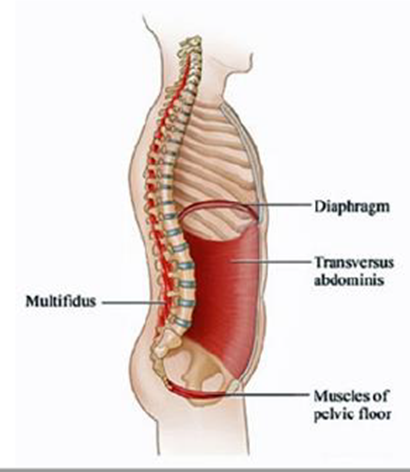
Most of the time when we hear the word “core” we think of our abdominals. And in fact it is important to keep the abdominals and all the other muscles of the trunk strong. These muscles work together to maintain good posture and to support and move the shoulders, the back, and the hips. They are often referred to as the powerhouse of the body, stabilizing the trunk and allowing us to move our arms and legs powerfully and safely during exercise.
Beneath these core muscles are the muscles of the inner core and they have an important job to do. The brain is protected by the scull, the heart and lungs are protected by the rib cage, and the female reproductive organs are protected by the pelvic bone. But the remaining organs are protected by the inner core. The muscles of the inner core are the diaphragm at the top, the multifidus in the back, the transverse abdominis in the front, and the pelvic floor at the bottom.
Diaphragm. A weakness in the diaphragm can lead to reflux. Diaphragmatic breathing strengthens the diaphragm. To practice diaphragmatic breathing, sit comfortably in a chair with the shoulders relaxed. Place one hand on your chest and the other hand just below your rib cage. Breathe in slowly through your nose so that the stomach moves out against your hand while the hand on your chest remains as still as possible. To exhale, tighten your stomach muscles so that your stomach moves back in while the hand on your chest remains as still as possible. Another way to make sure you are breathing diaphragmatically is to put the tip of your tongue on the roof of your mouth just behind your front teeth. This stimulates your vagus nerve ending, which is involved in the regulation of breathing, and causes diaphragmatic breathing. Practice diaphragmatic breathing in the pool. Breathing against the resistance of the water by submerging the chest strengthens the muscles of respiration. Deep water exercise is great for this because the chest is continually submerged. If you are teaching a shallow water class, it is a good idea to include exercises in the neutral position (Level II) or suspended (Level III) so that participants’ chests will be submerged for part of the class. For more information on diaphragmatic breathing see the article from the Cleveland Clinic.
Multifidus. A weakness in the multifidus can lead to slipped discs. Some exercises to strengthen the multifidus are:
- Bird dog. Get on your hands and knees, brace your core, lift one leg in back and the opposite arm in front.
- Superman. Lie face down on a mat with your arms extended in front of you. Simultaneously lift your arms, chest and legs off the mat. Hold for a few seconds.
- Side plank. Lie on your side with the elbow directly beneath your shoulder and your legs stacked. Lift your hips off the ground and hold for 20-30 seconds.
Another great way to strengthen the muscles of the back is to travel backwards in the pool. For more information on the multifidus see the article from Bret G. Ball, M.D., PhD. with Rose City Spine Surgery in Portland, Oregon.
Transverse abdominis. A weakness in the transverse abdominis can lead to a hernia. Some exercises to strengthen the transverse abdominis are:
- Toe taps. Lie on your back with your arms to the side and knees bent in tabletop position (knees bent at a 90-degree angle and shins parallel to the ground). Keep your knees bent and lower one foot to tap the toes on the ground.
- Bird dog. Get on your hands and knees, brace your core, lift one leg in back and the opposite arm in front.
- Plank. Start in a pushup position with your elbows and forearms at your side and your palms facing down. Raise your torso off the ground and hold the position for as long as you can.
In the pool, you can do a plank holding a noodle or foam dumbbells with the hands directly below the shoulders. For more information on the transverse abdominis, see the article from Healthline.
Pelvic floor. A weakness in the pelvic floor can lead to incontinence. Women are more likely than men to suffer from incontinence. However, in men sometimes an enlarged prostate exerts pressure on the urinary tract, controlling the flow of urine, and the the pelvic floor becomes weak. If the prostate is surgically removed, men will have a more serious issue with incontinence. Therefore both men and women are encouraged to include pelvic floor exercises in their fitness routine. A good exercise to strengthen the pelvic floor is Kegels. To perform Kegels correctly, lift the pelvic floor and then gently draw in the transverse abdominis. There should be no change in your breathing, and your upper abdominals should remain relaxed. Perform the exercise gently and slowly. How long to hold the core contraction depends on the type of incontinence you are having a problem with (or wish to avoid). Stress incontinence is leaking when sneezing, coughing, etc. For this do 10 quick pelvic floor lifts 2 or 3 times a day. Urge incontinence is leaking on the way to the bathroom. For this do a maximum of 10 repetitions at a time, hold the contraction for 10 seconds at most, and take a 30-second break in between contractions. Kegels can be performed standing, sitting or lying down. You can include them in your water fitness class while standing or try sitting on a noodle like a bicycle. Cue to lift the pelvic floor off the noodle. My resource for this information comes from Marietta Mehanni, the pelvic floor ambassador in Australia, who presented a workshop entitled “Aquacise Your Pelvic Floor” in Dallas on October 5, 2019. Bridges and squats can also help strengthen the pelvic floor. For more information on pelvic floor exercises, see the article from Medical News Today. Some of my participants have thanked me for including them in my classes.
See you in the pool!



